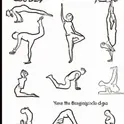Strength Building Yoga: Exercises To Overcome Muscle Weakness
Table of Contents
Introduction to Strength-Building Yoga
- Why Strength-Building Yoga?
- Overcoming Muscle Weakness: A New Approach
- The Benefits of Yoga for Strength Training
Conventional Approaches to Overcoming Muscle Weakness
- Resistance Training and Weightlifting
- Classic Exercises: Squats, Deadlifts, Bench Presses
- Risks and Challenges
- Bodyweight Exercises
- Push-Ups, Pull-Ups, Lunges
- Limitations and Plateaus
- High-Intensity Interval Training (HIIT)
- Intensity and Quick Workouts
- Potential Drawbacks
Why Conventional Approaches May Not Work for Everyone
- Specific Needs and Limitations of Different Populations
- Overemphasis on Isolated Strength
- Psychological Barriers
Introducing Strength-Building Yoga
- Overview of Strength-Building Yoga
- Combining Traditional Yoga with Strength-Focused Modifications
Key Strength-Building Yoga Exercises and Their Benefits
- Warrior Poses (Virabhadrasana I, II, III)
- Plank Variations (Standard, Side Plank, Dolphin Plank)
- Chair Pose (Utkatasana)
- Boat Pose (Navasana)
- Bridge Pose (Setu Bandhasana)
Why Strength-Building Yoga is Superior
- Comprehensive Muscle Engagement
- Accessibility and Adaptability
- Mental and Emotional Benefits
Addressing Counterarguments
- Perception of Yoga as "Not Intense Enough"
- Concerns about Lack of Cardiovascular Benefit
- Skepticism from Traditional Strength Trainers
Embrace Your Strength Journey
- Overcoming Frustration with Traditional Strength Training
- The Power of Strength-Building Yoga
- Starting Your Yoga Journey: Tips and Guidance
Conclusion
- Summarizing the Benefits of Strength-Building Yoga
- Encouraging a Holistic Approach to Fitness
- Final Thoughts and Motivational Message
Are you feeling frustrated with your strength training routine? Are you tired of the same old gym grind and not seeing the desired results? Trust me, you’re not alone. Imagine this: you’ve been lifting weights, pushing through those gruelling reps, but your muscles still feel weak. It's disheartening, right? You might be wondering if there’s a better way to build strength without all the strain and monotony. Well, I’m here to tell you there is, and it’s called strength-building yoga.
I get it. You’re skeptical. Maybe you think yoga is just about flexibility and calm breathing, not for serious muscle gains. But here’s the kicker: yoga can be a powerhouse for strength. Picture this: instead of the repetitive lifting of heavy weights, you’re engaging in fluid movements that not only build muscle but also enhance your balance and flexibility.
You’re probably thinking, “Can yoga make me stronger?” Absolutely. And it does so with a grace that weights simply can’t match.
Strength-building yoga isn’t just about adding another exercise to your routine. It’s about transforming how you approach strength training. Ready to give it a shot? Let’s dive into strength-building yoga and discover exercises that will redefine your fitness journey. Let's begin.
The Frustrations Of Conventional Strength Training
Resistance Training and Weightlifting
Resistance training and weightlifting have long been the go-to solutions for muscle weakness. Think of the classic exercises: squats, deadlifts, bench presses. These moves are staples in any gym routine, promising muscle hypertrophy and increased strength. Picture yourself at the gym, surrounded by the clang of weights and the grunts of lifters. It's a scene straight out of a fitness magazine. But let's be real. It's not all sunshine and rainbows.
First, there’s the risk of injury. Lifting heavy weights without proper form can lead to serious harm. Your lower back might scream at you after a poorly executed deadlift, or your shoulders might protest a heavy bench press. And then there's the need for equipment. Not everyone has access to a fully equipped gym. Even if you do, the sheer amount of gear can be overwhelming.
For many, especially beginners, resistance training can feel like an uphill battle. The learning curve is steep, and the potential for injury is high. It's easy to feel disheartened and frustrated when you don’t see immediate results.
Bodyweight Exercises
Next up, bodyweight exercises. Push-ups, pull-ups, and lunges these exercises don’t require any equipment and can be done anywhere. That's their big selling point. Imagine dropping into a quick set of push-ups in your living room, no gym membership required. It's straightforward, accessible, and convenient.
But here's the catch. Bodyweight exercises can only take you so far. Once you’ve mastered the basics, you might find yourself hitting a plateau. Sure, you can do more reps or add variations, but the challenge doesn't scale infinitely. Plus, these exercises often don’t target specific muscles effectively. They’re great for general fitness but might not address particular weaknesses you’re looking to overcome.
High-Intensity Interval Training (HIIT)
High-Intensity Interval Training (HIIT) is another popular method. HIIT workouts are intense and quick, combining bursts of vigorous activity with short rest periods. Picture a workout where you’re sprinting for 30 seconds, then resting for 15, then jumping right back into the fray. It’s a sweaty, heart-pounding session that promises to burn calories and build strength.
Yet, HIIT isn’t for everyone. The high impact can be tough on your joints, especially if you’re not used to such intensity. It’s easy to overdo it, leading to burnout or even injury. And let's face it, the sheer intensity of HIIT can be daunting. Not everyone is thrilled at the thought of pushing themselves to the brink in every session.
Why Traditional Workouts Fall Short
Specific Needs and Limitations of Different Populations
Not all workouts fit all people. Imagine an elderly person trying to keep up with a high-intensity HIIT class. Or someone with chronic pain attempting heavy weightlifting. It’s a recipe for disaster. These traditional approaches often overlook the needs of different populations.
For older adults, the risk of injury from lifting heavy weights is significant. People with chronic pain or injuries might find high-impact exercises exacerbate their conditions. Beginners, too, can feel overwhelmed by the complexity and intensity of these workouts. They need something more accessible, something that can be tailored to their unique needs.
Overemphasis on Isolated Strength
Traditional strength training often focuses on isolated muscle groups. Think of those bicep curls or leg presses. While these exercises can build specific muscles, they don’t always translate into functional strength. You might have killer biceps, but can you lift a heavy box without straining your back?
Functional movement is about using your muscles in harmony, just as you do in everyday life. Traditional methods can lead to imbalances, where some muscles are overdeveloped while others are neglected. This imbalance can increase the risk of injury and limit overall effectiveness.
Psychological Barriers
Let's talk about the mental game. The gym can be an intimidating place. The sight of people lifting enormous weights can make anyone feel inadequate. It's easy to feel self-conscious and out of place. This psychological barrier can be a huge deterrent.
Repetition can also be a drag. Doing the same exercises day in and day out can get boring fast. When boredom sets in, motivation takes a nosedive. You might start skipping workouts, and before you know it, you're back to square one.
Revolutionize Your Fitness With Strength-Building Yoga
Strength-building yoga isn’t just about flexibility and calm breathing. It combines traditional yoga poses with strength-focused modifications, engaging your muscles in holistic, functional movements. It’s a dynamic, engaging approach that keeps you moving and challenges your body in new ways.
Essential Yoga Poses For Strength And Balance
Warrior Poses (Virabhadrasana I, II, III)
Warrior poses are staples in yoga that double as strength builders. When you hold Warrior I, you engage your legs, core, and shoulders. It’s like a full-body workout in a single pose. Imagine standing strong, legs bent, arms reaching out, feeling the power coursing through your muscles. Warrior II and III add balance and stability to the mix. These poses aren’t just about holding still; they’re about finding and maintaining strength.
Plank Variations (Standard, Side Plank, Dolphin Plank)
Plank poses are deceptively simple yet incredibly effective. A standard plank engages your core, arms, and shoulders. It’s all about maintaining a straight line from head to heels. Try a side plank, and you’ll feel the burn in your obliques. Dolphin plank, with your forearms on the ground, takes it up a notch. Each variation targets different muscle groups while building overall body tension and control.
Chair Pose (Utkatasana)
Chair pose might look easy, but it’s a powerhouse for your lower body. Sitting back in an imaginary chair, you engage your quadriceps, glutes, and lower back. It’s like doing a squat but with added balance and endurance. Holding this pose builds stamina and strength, pushing your muscles to work harder than they do in everyday movements.
Boat Pose (Navasana)
The boat pose targets your core and hip flexors. Sitting on the floor, you lift your legs and hold them up, creating a V shape with your body. It’s all about balance and core strength. Imagine your abs and hip flexors working in harmony to keep you steady. This pose also promotes spinal strength and stability, crucial for overall body balance.
Bridge Pose (Setu Bandhasana)
Bridge pose is a fantastic way to strengthen your back, glutes, and hamstrings. Lying on your back, you lift your hips towards the sky, engaging your lower body and core. It’s a gentle yet powerful way to build muscle while improving flexibility and spinal alignment. Picture your body as a bridge, strong and stable, connecting strength and mobility.
Why Choose Strength-Building Yoga?
Comprehensive Muscle Engagement
Strength-building yoga is about using your muscles in concert. Each pose integrates multiple muscle groups, unlike isolated weightlifting exercises. This means you’re not just building muscle; you’re improving coordination and balance. Think of your body as an orchestra, where each muscle plays its part in harmony. The result? A symphony of strength that translates into everyday functional movements.
Accessibility And Adaptability
Yoga is for everyone. Whether you’re a seasoned athlete or a complete beginner, yoga can be adapted to fit your needs. The risk of injury is minimal with proper guidance, making it a safe option for older adults or those with chronic pain. Plus, you don’t need any fancy equipment. A mat and some space are all you need. Yoga meets you where you are, offering a path to strength that’s as challenging or gentle as you need it to be.
Mental and Emotional Benefits
Strength-building yoga isn’t just about the physical. It’s also about mental clarity and emotional well-being. The focus on breath and movement helps reduce stress and improve mental focus. Imagine ending a session feeling not just stronger, but also calmer and more centred. The mind-body connection fostered by yoga enhances your overall health, making you more resilient both physically and mentally.
Debunking Myths About Yoga And Strength
Perception Of Yoga As "Not Intense Enough"
Some might think yoga can’t possibly be intense enough for real strength building. But they haven’t tried holding a Warrior III or a plank for extended periods. Advanced poses challenge your muscles in ways traditional exercises can’t. And there’s evidence to back it up. Studies have shown that yoga practitioners experience significant strength gains. Don’t be fooled by the calm exterior; yoga is a silent strength-builder.
Concerns About Lack Of Cardiovascular Benefit
Worried that yoga won’t get your heart pumping? Dynamic yoga flows and sequences can elevate your heart rate, providing a cardiovascular workout. Think of a fast-paced vinyasa session, where you’re moving from one pose to another in a fluid, continuous flow. Your heart will race, and you’ll break a sweat. Plus, yoga complements other cardio activities, creating a balanced fitness routine.
Scepticism From Traditional Strength Trainers
Traditional strength trainers might scoff at yoga, seeing it as a lesser form of exercise. However, many former weightlifters and athletes have turned to yoga for its holistic benefits. Testimonials and case studies show that those who incorporate yoga into their routines not only maintain but often enhance their strength. Research supports these findings, highlighting the effectiveness of yoga in building muscle and improving overall fitness.
Embrace Your Strength Journey
Feeling overwhelmed by traditional strength training? You’re not alone. It's easy to get disheartened when the gym routine feels like a grind, and you're not seeing the results you crave. You might be thinking, “Is there a better way to build muscle without the risk and monotony?” Absolutely. Strength-building yoga is your answer, and it’s more powerful than you might think.
Imagine stepping onto your mat, ready to conquer new challenges. You've learned that yoga isn’t just about flexibility and calm; it’s about building a resilient, powerful body. Remember those Warrior poses that engage your legs, core, and shoulders? Or the plank variations that challenge your entire body? These aren't just exercises; they're a path to holistic strength.
Think about the accessibility of yoga. No need for fancy equipment or a gym membership. Just you, your mat, and a commitment to improvement. It's perfect for anyone, from beginners to seasoned athletes, and adapts to your needs. Yoga meets you where you are and helps you grow stronger every day.
And let's not forget the mental and emotional benefits. Yoga reduces stress, enhances focus, and connects mind and body. You end each session not just physically stronger, but also more centered and calm. This isn’t just a workout; it’s a transformation.
So, if you’re ready to break free from the old ways and embrace a new, more balanced approach to strength training, strength-building yoga is your way forward. It’s time to overcome muscle weakness and unlock your potential. You’ve got this. Embrace the journey, feel the power within, and step confidently into a stronger, healthier you. Let’s roll out that mat and get started!
People Also Asked
1. Can yoga help build muscle strength?
Answer: Yes, yoga can significantly improve muscle strength. Strength-building yoga incorporates poses that engage multiple muscle groups, enhancing both endurance and functional strength. Poses like Warrior, Plank, and Chair pose challenge your muscles in ways similar to traditional strength training.
2. Do I need to be flexible to start strength-building yoga?
Answer: No, flexibility is not a prerequisite for starting strength-building yoga. Yoga will naturally improve your flexibility over time. The focus is on building strength through controlled, mindful movements, which will gradually enhance your flexibility as well.
3. How often should I practice strength-building yoga to see results?
Answer: For noticeable results, aim to practice strength-building yoga at least 3-4 times per week. Consistency is key. Even short, daily sessions can be highly effective in building strength and improving overall fitness.
4. Do I need any special equipment for strength-building yoga?
Answer: No special equipment is needed. A yoga mat is usually sufficient. Some practitioners use blocks, straps, or resistance bands to aid in certain poses, but these are optional and can be gradually incorporated as you advance.
5. Can strength-building yoga replace my current strength training routine?
Answer: Strength-building yoga can be a complete strength training routine or a complement to your existing one. It offers a holistic approach by incorporating flexibility, balance, and mental focus, which can enhance your overall fitness and complement traditional strength training.
6. Is strength-building yoga suitable for beginners?
Answer: Absolutely. Strength-building yoga can be tailored to all fitness levels, including beginners. Start with basic poses and gradually progress to more advanced variations as your strength and confidence improve.
7. Can strength-building yoga help with chronic pain or injuries?
Answer: Yes, strength-building yoga can be beneficial for managing chronic pain and recovering from injuries. It focuses on controlled movements and body awareness, which can help in strengthening the muscles around injured areas, improving flexibility, and reducing pain. However, it’s important to consult with a healthcare professional before starting any new exercise routine.
8. Will yoga provide cardiovascular benefits?
Answer: While traditional yoga might not be as intense as cardio workouts, dynamic sequences in strength-building yoga can elevate your heart rate and provide cardiovascular benefits. Fast-paced vinyasa flows or power yoga sessions can give you a good cardiovascular workout.
9. How does yoga improve mental and emotional well-being?
Answer: Yoga emphasizes the mind-body connection through breath control, meditation, and mindful movements. This holistic approach helps reduce stress, improve focus, and enhance emotional resilience, contributing to overall mental and emotional well-being.
10. How long does it take to see results from strength-building yoga?
Answer: Results can vary based on individual factors like frequency of practice, initial fitness level, and consistency. Generally, practitioners may start noticing improvements in strength, flexibility, and mental clarity within a few weeks of regular practice. For significant muscle gains, it may take a few months of consistent practice.





